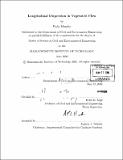Longitudinal dispersion in vegetated flow
Author(s)
Murphy, Enda
DownloadFull printable version (8.825Mb)
Other Contributors
Massachusetts Institute of Technology. Dept. of Civil and Environmental Engineering.
Advisor
Heidi M. Nepf.
Terms of use
Metadata
Show full item recordAbstract
Vegetation is ubiquitous in rivers, estuaries and wetlands, strongly influencing both water conveyance and mass transport. The plant canopy affects both mean and turbulent flow structure, and thus both advection and dispersion. Accurate prediction of the fate and transport of nutrients, microbes, dissolved oxygen and other scalars depends on our ability to quantify vegetative impacts. In this thesis, the focus is on longitudinal dispersion, which traditionally has been modeled by drawing analogy to rough boundary layers. This approach is inappropriate in many cases, as the vegetation provides a significant dead zone, which may trap scalars and augment dispersion. The dead zone process is not captured in the rough boundary model. This thesis describes a new theoretical model for longitudinal dispersion in a vegetated channel, which isolates three separate contributory processes. To evaluate the performance of the model, tracer experiments and velocity measurements were conducted in a laboratory flume. Results show that the mechanism of exchange between the free stream and the vegetated region is critical to the overall dispersion, and is primarily controlled by the canopy density. (cont.) A numerical random walk particle-tracking model was developed to assess the uncertainty associated with the experimental data. Results suggest that the time scale required to obtain sound experimental data in tracer studies is longer than the commonly used Fickian time scale.
Description
Thesis (S.M.)--Massachusetts Institute of Technology, Dept. of Civil and Environmental Engineering, 2006. Includes bibliographical references (p. 171-183).
Date issued
2006Department
Massachusetts Institute of Technology. Department of Civil and Environmental EngineeringPublisher
Massachusetts Institute of Technology
Keywords
Civil and Environmental Engineering.